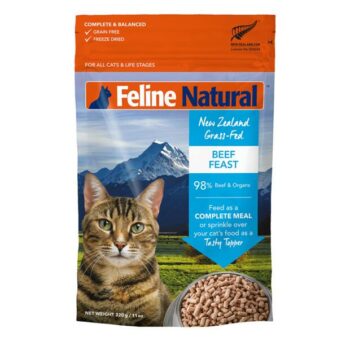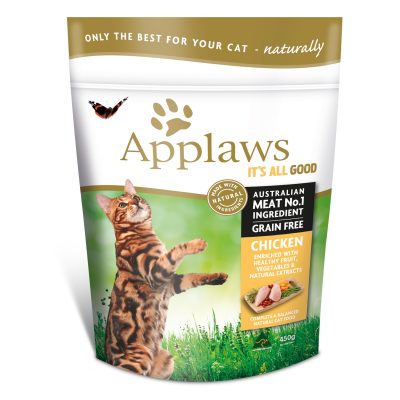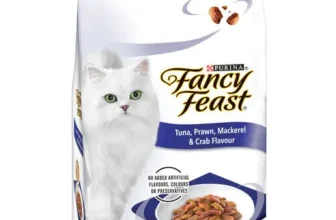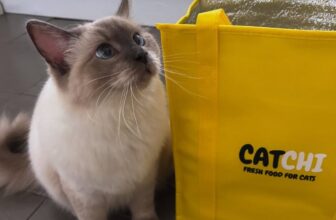Feline Natural Cat Food Review

Nature knows best, and our cats were biologically designed to thrive off raw meat, organs, and bones from prey animals – not the starchy carbs you find in most excuses for cat food.
However, feeding your cat a raw diet is off-putting if you haven’t brushed up on all the nutrients they require to live a long and healthy life.
If that’s you, then you’ll love Feline Natural – it’s a fantastic way to feed your cat a balanced raw food diet, but with all the benefits, convenience, and long shelf life of kibble!
What more could you ask for?
Why freeze dried cat food offers the best nutrition
Freeze drying is a process of removing the moisture from a food while leaving all the nutrients intact.
When it comes to Feline Natural, this means the pellets (if that’s what you call them) are nutrient powerhouses for your cat.
You simply add the water back into the cat food and let it soak a few minutes before feeding.
This means when you buy Feline Natural based on the weight, you’re not paying for moisture like you are with wet cat foods. Also, when you reconstitute the pellets with water, you know you’re adding fresh and clean water which is vital for your cat’s health.
When it comes to other styles of cat food, keep in mind kibble is cooked at high temperatures (some ingredients multiple times), and the higher the temperature the more the nutrients are damaged.
Feline Natural, as you’ll see below, is made from all the right ingredients which will truly benefit your cat’s health, in a form where nutrients remain fully intact.
What the ingredients say
Let’s take a look at the Beef & Hoki formula, although all formulas (including the wet canned foods) will offer you variety and a mix of nutrition.
Keeping in mind most kibbles are jam packed with grains, potatoes, or other stuff they struggle to digest, and you’ll appreciate how beneficial Feline Natural is for your cat’s health:
- Beef Heart – An excellent source of taurine and CoQ10 to support the heart health and energy levels of your cat. Vital given how many cats suffer from heart issues and heart murmurs from lack of taurine in kibble/canned diets.
- Hoki – Absolutely packed with omega-3 fatty acids to support your cat’s skin, coat, and joints.
- Beef – High-quality protein to maintain strong muscles and overall vitality in your cat.
- Beef Kidney – Essential B vitamins and minerals to support your cat’s metabolism and organ function.
- Beef Liver – Loaded with vitamin A and iron to boost your cat’s immune system and vitality.
- Beef Blood – It may sound yucky, but this is a natural source of iron and amino acids to give your cat energy and support wellbeing.
- Sunflower Oil – Provides linoleic acid to keep your cat’s skin healthy and coat soft and glossy. I prefer animal based oils, but it’s a moot point given the other ingredients.
- Flaxseed Flakes – Although plant-based, flaxseed is a great source of omega-3s and also fibre to support your cat’s digestion (older cats can really benefit from quality fibre in the diet).
- New Zealand Green Mussels (Perna Canaliculus) – An excellent addition, New Zealand green mussels are a source of glucosamine and chondroitin to help prevent your cat developing joint issues and arthritis.
- Dried Kelp – Super healthy, kelp is rich in iodine to help regulate your cat’s thyroid and support their metabolism.
Is Feline Natural too expensive?
When you consider the quality of ingredients in Feline Natural, and how you’re not paying for water content, it isn’t as expensive as you may think. Especially when you consider the health benefits for your cat.
That said, most of us are constrained by the ever-increasing costs of pet food and produce in general.
The solution to that is not to feed Feline Natural all the time. Use it as a topper to mix with your cat’s usual food, or make it a special meal once or twice a week. As a freeze-dried cat food it lasts for ages, so you don’t need to worry about it going off.
I highly recommend Feline Natural. It’s a great cat food, proven worldwide with huge amounts of resoundingly good feedback from cat owners.
How you can improve on Feline Natural – Raw meaty bones
The one issue I have with most cat foods, whether dry biscuits, canned, or even premium styles of food like air-dried or freeze-dried, is they do very little to keep plaque forming on your cat’s teeth.
When feeding our cats we often forget how cheap and easy it is to give them real meats, organs, and bones. If you don’t want to feed your cat a homemade raw diet (i.e. you’re concerned about getting the balance right), then try and give your cat a tasty chicken wing or chicken neck to chew on a few times a week – this will help then naturally clean their teeth, and hey, nature intended them to eat raw meat and bones!
Where to buy
Ingredients
The ingredients of Feline Natural cat food (Freeze dried Beef & Hoki):
Beef Heart, Hoki, Beef, Beef Kidney, Beef Liver, Beef Blood, Sunflower Oil, Flaxseed Flakes, New Zealand Green Mussels (Perna Canaliculus), Dried Kelp, Vitamin E Supplement, Zinc Proteinate, Canola Oil, Manganese Proteinate, Thiamine Mononitrate, Vitamin D3 Supplement, Folic Acid.

Join the Reddit community r/HealthyAussiePets







I switched to both Feline Natural and Ziwi Peak when my burmese boys reached 10 months of age. They Love it! especially the dried freeze variety of the feline natural. I mix both the freeze dried and the the wet food together to give it a more hydrated texture.
I still have some royal canin kitten biscuits left over which I have tried to give them every now and then, and they have turned their noses up at it.
I dont think you can go wrong with both of these products. Yes they are pricey, but compared to some of the supermarket cat food, I believe these two products are better for my boys in the long run.
You sound like an expert and I’ll place a lot of weight in what you have to say, but there is absolutely no proof that glucosamine has any effect whatsoever.
If you give bone broth which is pretty much full of glucosamine and chondroitin, hyularonic acid and collagen, than give extra collagen with rosehips, colostrum and MSM. These do work, my girl has luxating patellas on both back legs, since being on these she hasn’t been in pain. She screams with even the tiniest pain, so since she hasn’t screamed, she mustn’t be in pain anymore.
One thing I can say for certain doesn’t work is green lipped mussels. Tried for 3 months what a waste of time.
I use Bioglan joints plus and this works for me too. So I do think that some do work, I think the issue is finding what works for you and your pets (unique) body chemistry.
Because for some people nothing works, whilst for others the cheapest stuff works.
Also noted that joint oils for people don’t work, but for dogs they do. But maybe cause the dog ones are like the absolute best quality, whereas the human ones are usually the cheapest to produce and the worst quality. To get the quality stuff you have to pay like 4x more, not meaning you’ll get any benefit regardless.
Now actual joint supplements inside of foods are useless, never noticed any effect. I think the amounts are honestly just too small. Small dogs require a minimum 500mg glucosamine and than 1000mg for medium and 1500mg for large. Dog foods are usually around 400mg per kilo of food. They need 500mg a day, so if a small dog only eats 100g that’s only 40mg per day. No wonder it has zero effect. Even Orijen wouldn’t meet the minimum daily for small dogs.
Best to just buy a supplement with like 4-5 different joint stuff in it and give the minimum over a 3 month period (minimum time). Because at least that way they get the full dose per day and it may actually work. Even the vet joint stuff doesn’t have enough for the minimums.
Glucosamine is used to treat arthritis in humans as well as often being recommended by vets, but that said with any ingredient in pet food it’s often hard to ascertain whether there’s any real benefit, or any real benefit to a specific dog. Questions such as “is there enough of the ingredient to provide benefit”, “is it a quality inclusion of the ingredient”, or “is the research sufficient” are all valid and can be speculated upon. In the case of glucosamine you could well be right given this page on the National Center for Complementary and Integrative Health (US) states “Major studies of glucosamine for osteoarthritis of the knee have had conflicting results.”.
HI, are there reviews for cat wet food? I’m wondering about ziwipeak vs feline natural for wet food…any thoughts? Thanks for a great website
Should I leave a truthful message? I was just reading Feline Natural freeze dried Beef and Hoki. I expected high quality ingredients 100% especially they say it’s worth the high cost. I don’t buy it anymore for whatever reason my cat started to vomit it, plus she doesn’t even go near it.
Anyway, I don’t like the Sunflower oil, and you even added Canola oil….Cooking oil? Can you not do better for the money, like salmon oil.
What’s Happening ?
Hi V G, of course you can write a truthful message, and messages such as this can help others. I’m sorry to hear your cat was sick on Feline Natural, and I hope other cats haven’t been affected.
Hi Jane, no wet food reviews as yet but generally if the “dry” food is rated highly then the wet variety will be equal (or better). Both Ziwipeak and Feline Natural wet foods are really good (with a price tag to match), and there’s no reason you shouldn’t feed one, the other, or both!
This was my favourite back up to prey model raw for ferrets until they changed the recipes to include too much plant matter for my liking; I’d probably still feed it to a cat though 🙂
The new ingredient list for the Chicken/Lamb:
Chicken, Lamb Heart, Lamb Kidney, Lamb Liver, Lamb Blood, Flaxseed Flakes, New Zealand Green Mussel, Dried Kelp, Vitamin E Supplement, Zinc Proteinate, Canola Oil, Manganese Proteinate, Thiamine Mononitrate, Vitamin D3 Supplement, Folic Acid.
Well at the end of the day flaxseed always helps with skin and coat but fish definitely helps better, without kelp they would need to supplement with synthetic vitamins so I prefer the kelp, I’d imagine it’s similar to the dry seaweed I eat tastes awful but full of vitamins and minerals you may not get often enough.
Not sure why they decided to use canola oil though, the dog formulas use sunflower oil which is better but olive oil is best.
There’s a dog food out there that puts like 500ml of olive oil in each big bag of kibble, not sure how much is in the smaller bags, but that’s a lot regardless.
Ziwipeak canned used to have olive oil, after the change they no longer do 🙁